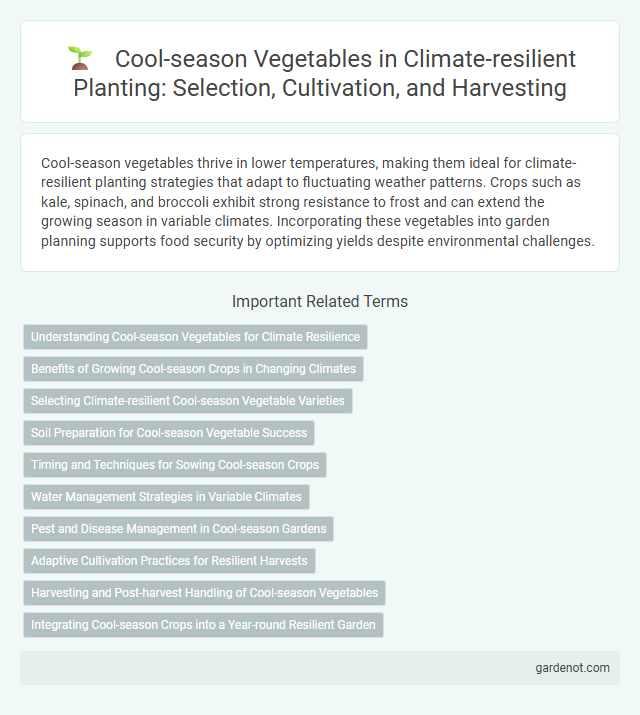Cool-season vegetables thrive in lower temperatures, making them ideal for climate-resilient planting strategies that adapt to fluctuating weather patterns. Crops such as kale, spinach, and broccoli exhibit strong resistance to frost and can extend the growing season in variable climates. Incorporating these vegetables into garden planning supports food security by optimizing yields despite environmental challenges.
Understanding Cool-season Vegetables for Climate Resilience
Cool-season vegetables such as spinach, kale, and broccoli thrive in temperatures between 45degF and 75degF, making them ideal for climate-resilient planting during cooler months. These crops have a shorter growing cycle and exhibit tolerance to frost, which helps maintain productivity despite unpredictable weather patterns. Incorporating cool-season vegetables into crop rotation enhances soil health and provides a sustainable food source amid climate variability.
Benefits of Growing Cool-season Crops in Changing Climates
Growing cool-season vegetables such as spinach, kale, and broccoli enhances climate-resilient planting by thriving in lower temperatures and tolerating frost, which reduces crop loss during unpredictable weather patterns. These crops contribute to soil health through extended growing seasons, improving organic matter and reducing erosion. Cultivating cool-season vegetables supports food security by diversifying production cycles and ensuring continuous harvests despite shifting climate conditions.
Selecting Climate-resilient Cool-season Vegetable Varieties
Selecting climate-resilient cool-season vegetable varieties involves prioritizing crops that tolerate temperature fluctuations, drought, and disease resistance. Varieties such as kale, spinach, and broccoli exhibit strong adaptive traits for cooler climates with unpredictable weather patterns. Integrating these resilient vegetables supports sustainable yields and enhances food security in regions facing climate variability.
Soil Preparation for Cool-season Vegetable Success
Proper soil preparation for cool-season vegetables involves testing and amending soil to achieve a pH between 6.0 and 7.0, ensuring optimal nutrient availability. Incorporating organic matter like compost enhances soil structure, moisture retention, and microbial activity crucial for seedling establishment in cooler temperatures. Raised beds and well-drained soil prevent waterlogging and root rot, promoting robust growth during fluctuating spring and fall conditions.
Timing and Techniques for Sowing Cool-season Crops
Sowing cool-season vegetables such as broccoli, lettuce, and spinach requires precise timing to optimize growth and resilience against temperature fluctuations. Plant seeds in early spring or late summer, ensuring soil temperatures remain between 45degF and 75degF for ideal germination. Techniques like using row covers and raised beds enhance microclimate control, reducing frost risk and promoting healthy seedling development.
Water Management Strategies in Variable Climates
Cool-season vegetables benefit from precise water management strategies that optimize soil moisture retention and reduce evapotranspiration, crucial in variable climates experiencing irregular rainfall patterns. Implementing drip irrigation systems and mulching effectively conserves water while maintaining consistent moisture levels essential for crops like spinach, kale, and broccoli. Monitoring soil moisture through sensors enables adaptive watering schedules that prevent both drought stress and waterlogging, ensuring climate-resilient planting success.
Pest and Disease Management in Cool-season Gardens
Effective pest and disease management in cool-season vegetable gardens involves selecting resistant varieties and implementing crop rotation to disrupt pest life cycles. Applying organic mulches helps maintain soil moisture and reduces fungal infections, while timely removal of infected plant debris minimizes disease spread. Biological controls such as beneficial insects and neem oil sprays provide eco-friendly protection without harming the garden's ecosystem.
Adaptive Cultivation Practices for Resilient Harvests
Cool-season vegetables such as spinach, kale, and broccoli thrive under adaptive cultivation practices that mitigate temperature extremes and optimize water use efficiency. Implementing techniques like raised beds, mulching, and strategic planting schedules enhances soil moisture retention and reduces heat stress during unexpected warm spells. These practices contribute to resilient harvests by sustaining crop productivity and quality in fluctuating climatic conditions.
Harvesting and Post-harvest Handling of Cool-season Vegetables
Harvesting cool-season vegetables at the peak of maturity ensures optimal nutrient retention and flavor quality, enhancing market value and shelf life. Post-harvest handling techniques such as quick cooling, proper washing, and hygienic packaging are critical in reducing spoilage and maintaining firmness. Employing climate-resilient practices like shade protection and moisture control during storage further extends freshness and minimizes losses under variable weather conditions.
Integrating Cool-season Crops into a Year-round Resilient Garden
Incorporating cool-season vegetables such as kale, spinach, and Brussels sprouts into year-round gardens enhances climate resilience by extending the harvest period and diversifying crop production. These crops tolerate lower temperatures and thrive in early spring and late fall, reducing the risk of crop failure during extreme heat or drought conditions. Utilizing cover cropping and crop rotation with cool-season varieties improves soil health and moisture retention, supporting sustainable, resilient agricultural systems.
Cool-season vegetable Infographic

 gardenot.com
gardenot.com